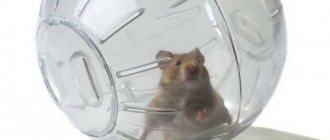What is required for maintenance
Proper keeping of a hamster at home can not only improve the well-being and health of the small rodent, but also prolong its life. If you create all the conditions for a comfortable existence, the hamster will live a long and happy life without stress.
To keep a pet hamster you need:
- cell;
- house;
- toys;
- feeders 2 pieces;
- drinking bowl;
- running wheel, ball, maze, playground or tunnel.
When choosing a cage, you need to take into account the number and type of hamsters you plan to keep. It is not recommended to house several hamsters in one cage, but in practice it turns out differently. The minimum cage size for one rodent is 60 by 40 cm. It is important that the bars of the cage are positioned horizontally, since hamsters are very active and love to climb the walls of the cage.
The cage must be selected specifically for small rodents. Since the distance between the rods plays an important role. If you are planning to get dwarf hamsters, choose a distance so that a small hamster cannot fit between them.
To keep hamsters, they often buy a cage. But you can use an aquarium. It is important that the size of the aquarium also corresponds to the minimum size of 60 by 40 cm per pet, and the number of hamsters living.
Under no circumstances should hamsters be kept in cardboard boxes or plastic containers. Hamsters are rodents; their teeth grow throughout their lives. They will instantly chew up a dwelling made of fragile material and run away. Finding and catching an escaped hamster is not an easy task. But besides this, he can also get poisoned.
Independence
There are situations in everyone's life when there is only enough time for work, sleep and a quick snack. During such periods of life, dog and cat owners find themselves in a very difficult situation. You need to walk your dog every day and communicate with your cat; hamsters are more unpretentious in this regard. As long as the hamster has water, food, clean bedding, a running wheel, a house and a few toys, he is relatively happy. And if you decide to get a pair of Djungarian hamsters, they will be completely autonomous.
Pros and cons of content
Pros of keeping a hamster
- low cost of a hamster;
- low cost of accessories for maintenance;
- takes up little space;
- does not require special care and knowledge;
- does not make noise;
- no wool;
- no need for daily walks;
- you can keep one hamster, without a pair;
- does not pose a danger to both adults and children;
- easy to breed;
- easy to place the babies.
Disadvantages of keeping a hamster
- they sleep during the day and are active at night;
- unpleasant odor if you do not clean up food debris and excrement daily;
- low life expectancy, from 2 to 3 years;
- some individuals hibernate, depending on the species and conditions of detention.
To take or not to take
Before you buy yourself a hamster, for example, a Djungarian, you need to think in advance and weigh everything that may be associated with this animal. First of all, remember that the hamster is a very territorial animal, which means it should be kept alone. Two individuals most likely will not get along in the same cage and such proximity will not lead to anything good.
If you live in an apartment and are wondering whether it’s worth getting a hamster, let’s analyze together all the pros and cons of keeping this animal.
Choosing a location for the cage
Often owners do not pay attention to where to place the hamster's cage. This is a rather important point, which affects both the health and life expectancy of the animal.
Things to consider when choosing a location for a cage:
- Avoid direct sunlight on the cage;
- avoid bright light;
- limit access to the cage for other animals;
- avoid drafts;
- there should be no temperature changes in the room;
- do not place under air conditioning;
- do not place near heating devices;
- there should be no strong odors or smoke in the room;
- do not place near a TV, radio, or stereo system;
- do not place the cage in a walk-through area;
- Do not place it in a children's playroom, as hamsters are afraid of sharp and loud sounds.
For the cage you need to choose a quiet, non-passable place. The cage should not be moved frequently. The optimal temperature for keeping hamsters is 20-25 degrees.
It is necessary to install a house in the cage so that the hamster can rest during the daytime and feel safe. Also in the cage you need to put 2 feeders and a drinking bowl. Feeders with drinking bowls must be attached to the bars of the cage, otherwise an active animal will definitely turn over and trample the contents. One feeder is needed for the grain mixture, which is the main feed, the other is needed for succulent feed.
It is worth considering that hamsters are very mobile and active animals. They definitely need to buy and install a treadmill, ball, tunnels, and labyrinths in the cage. Special playgrounds for hamsters are sold, which already include the listed attractions, as well as various toys for the hamster.
Choosing a hamster
If you want your pet to please you with good health and good mood for a long time, choose it responsibly. Determining whether an animal is healthy is not at all difficult. When purchasing, be sure to pay attention to the following points:
- The animal's fur should be shiny and free from bald spots.
- Clear eyes, absence of suppuration and spots are an important indicator of the animal’s condition.
- Be sure to inspect the animal's anus and the fur around it. They shouldn't be dirty. Diarrhea often indicates an infectious disease.
- The nose should be clean and pinkish in color.
- If the dwarf is sleeping, be sure to wake him up and observe his behavior. Hamsters are very active by nature. Lethargy can be caused by illness or severe stress, which often happens in crowded and stuffy cages of a pet store. Animals are known to be more susceptible to illness during times of stress, so avoid purchasing.
Don't forget to consider transporting your pet home. To transport a hamster, veterinarians recommend purchasing a special carrier. At the bottom you should put a little sawdust, as well as a few pieces of carrots. If transportation will take more than 2 hours, be sure to provide the animal with access to water by hanging a drinking bowl.
You can carry a hamster in your arms only if it is not afraid of you and the journey will take no more than half an hour. This method is completely unsuitable for the first transportation of dzhungarika home.
Hamster care
Cleaning
One of the main disadvantages of keeping hamsters is the unpleasant smell from the cage. To avoid this, you need to clean the cage daily and keep it clean. However, frequent cleaning worries the hamster and leads to stress, which greatly reduces life expectancy.
Before you start cleaning the cage, you need to move the hamster to another place. Then remove any remaining food, wash the feeders and drinking bowls, check and remove supplies from the hamster’s pantry, and remove excrement. As soon as you have finished cleaning, you need to return the hamster back.
To prevent an unpleasant odor from excrement, the bottom of the cage is covered with corn or cellulose filler. Newspapers or sawdust are often used as bedding. However, such material is one of the reasons for the unpleasant odor and the cage needs to be cleaned much more often.
General cleaning is carried out 2-3 times a month. This type of cleaning includes a complete change of filler and a complete wash of the cage.
Feeding
Hamsters are omnivores, so it is important to know what you can and cannot feed your hamster.
- The basis of a hamster's diet is a grain mixture. You can purchase ready-made grain food at a pet store, or purchase grains separately and mix them yourself.
- Vegetables and fruits must be included in a hamster's diet. Vegetables are a source of fiber, which aids digestion, and fruits are an excellent source of vitamins. Among the vegetables, the hamster is often fed carrots, cucumbers, bell peppers and zucchini. Hamsters are very fond of apples and pears as fruits.
- It is also worth taking care of your pet's health. Hamsters need to wear down their teeth, which grow throughout their lives. To do this, you can hang a mineral stone in the tap hole, which is also beneficial for the body. Hamsters are also given branches of apple, pear, and birch trees.
We discussed a complete list of foods that can be given to a hamster in the article What does a hamster eat.
Communication
- Hamsters are very active and sociable pets. They quickly get used to humans and are easy to tame. It is important to avoid long breaks when in contact with a hamster. Because the rodent also quickly loses the habit and has to be tamed again.
- Contact with the hamster should be established gradually. It is not recommended to disturb the hamster during the first days in the house. During the first week, he needs to be given time to settle into the new territory and get used to the person, his smell and voice.
- It is worth considering that the hamster is a nocturnal animal. Under no circumstances should he be woken up during the day. Also, when communicating, you should not make loud sounds, make noise, shout or make sudden movements.
- You should handle your hamster with extreme caution. Taking him from the back is highly discouraged, as this causes him to associate it with an attack by a predator. You need to place your palm and wait for the hamster to climb onto it.
- It's worth being careful. Do not squeeze it too tightly in your hands, and also make sure that it does not slip out of your hands. Hamsters can be injured if they fall from a height.
- Hamsters are very clean. There is no need to wash them unless they are soiled with feces. If you still need to bathe your hamster, you need to make sure that water does not get into the eyes, ears and nose. After bathing procedures, you cannot blow dry your hamster!
Hamsters at home live on average 2-3 years. They are very timid and often exposed to stress. If you follow simple rules for caring for and keeping hamsters at home, they will delight you throughout their lives.
First pet
When choosing a child's first pet, many parents are horrified at the prospect of having a dog or cat that will eventually be cared for by adults. A hamster or other rodent, in this regard, is the best option.
A child over 7 years old will be able to take care of a pet independently, and this instills a sense of responsibility. Naturally, you need to sensibly assess the child’s readiness to care for a miniature rodent. If the baby tends to quickly switch from one priority to another, to carelessly handle animals, or is too active, it is better for him to look for a “stronger” pet or postpone this idea for the future.
Housing problem
The first thing that needs to be prepared for a new settler is his home. A hamster's home should be free, spacious, clean and cheerful. Your pet needs a lot of space to play and run around, as well as a lot of exercise equipment, such as wheels and toys for self-entertainment.
For the convenience of the animal, the cage floor should be covered with sawdust and soft straw, so that the little tomboy can feel at ease and comfortable, because they love to pick at something.
During the day, babies prefer to rest from a busy night, which is why their cage should have space for a sleeping place. Most likely it will be some kind of box, or a whole house, since their range in pet stores is quite wide, into which light will not pass.
Hamsters are heat-loving creatures. They inherited this from their wild relatives, whose habitat is the hot, dry desert. Therefore, when looking for a place to install the cage, bet on a warm, secluded corner near the radiator and away from drafts.
However, it is not recommended to place small rodents in your or your child’s bedroom, since these babies tend to be active at night, which will disturb your sweet sleep.











